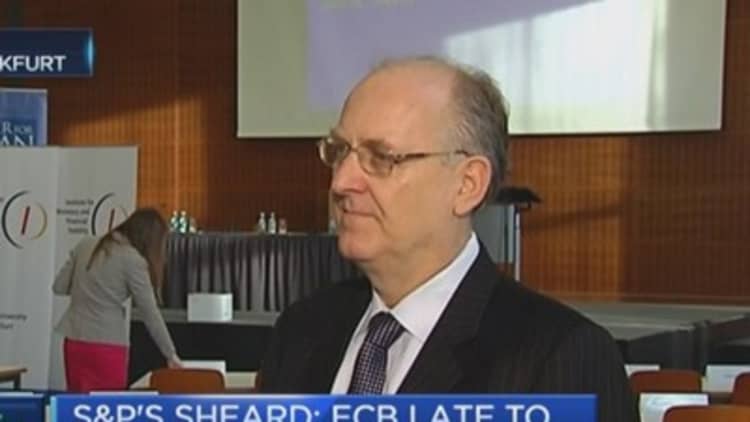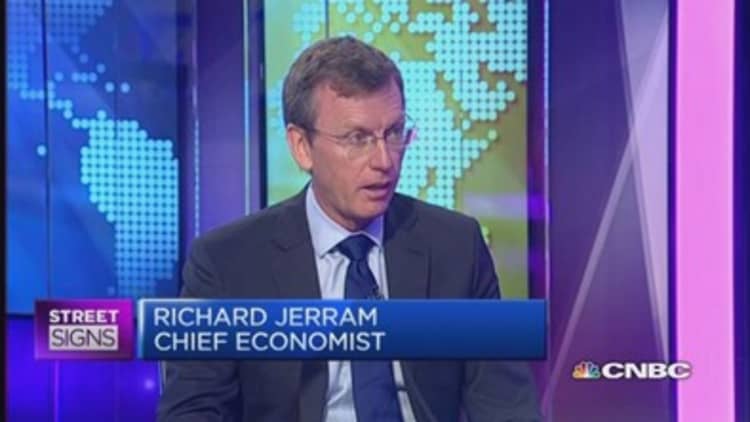


As the trades around a 12-year low against the dollar, analysts believe euro-dollar parity will be reached soon—and that the single currency could weaken even further.
It comes as the European Central Bank's quantitative easing (QE) program to stimulate the euro zone's lackluster economy got underway on Monday.
Expectations of the move – which will see euros flood the market -- sent the currency below $1.1000 for the first time since September 2003 on Friday. The currency has since weakened further and in afternoon trade Wednesday, the euro was stuck around $1.058.
Now analysts are questioning how long it will take for the euro to reach parity with the dollar – and potentially fall below 1:1 against the greenback.
Read MoreNowhere but down? Euro reacts to QE
"I think we're heading towards parity and that's the logical conclusion of where we're heading next," David Zahn, head of European Fixed Income at Franklin Templeton, told CNBC Wednesday.
"Originally, I was thinking next year (we'd see parity), but at the rate we're going it does seem like it could be much sooner than that."
But he said the ECB shouldn't be worried at the rate of decline yet, adding: "I think they will become concerned if the pace becomes too quick."
Michael Hewson, chief market analyst at CMC Markets, said the single currency had the potentially move even lower.
"Few would have imagined in May last year when EURUSD was trading just shy of 1.4000 that nearly 10 months later the currency would have slid nearly 35 percent to be trading just short of 1.0700 with the potential to go even lower," he said in a note, entitled "How low can the euro go?" on Wednesday.
"The next target sits at 1.0500 -- the March 2003 low -- and it remains a very short hop from there to parity."
A senior currency strategist at Societe Generale agreed that the euro was headed to $1.05 and could reach parity with the dollar in a few weeks.
"The size of the move you're seeing is really a reflection of the intensity of QE and it's forcing people to realize that they own too many of the euro assets…$1.05 is going to come fairly soon and parity is a possibility in the next few weeks," Sebastien Galy told CNBC Tuesday.
However, Galy warned that it was, "very rare for the market to be so right at the start of the year and not get burned very badly at some point," and that some consolidation was likely.
'Euroglut here to stay'
Currencies tend to weaken during QE as the bond purchases by central banks boost the amount of money in circulation. Lower interest rates compound the effect as they encourage consumers to spend and businesses to invest, boosting the economy.
A weak euro is broadly positive for the struggling euro zone, and should help it tackle deflation and stimulate the region's exports, which become cheaper in the global market as a result.
Conversely, a strengthening dollar worries U.S. exporters, as it makes their products more expensive in foreign markets.
The weakness in the euro has been compounded by concerns that Greece – which is battling an ongoing economic crisis -- could ultimately leave the single currency and others could follow, undermining the future of single currently. Expectations of a rate hike by the Federal Reserve on the back of a strengthening U.S. economy is also giving the dollar a boost.
The ECB's 1 trillion euro bond buying program has, predictably, caused the yields on euro zone sovereign debt hit record lows (and, conversely, prices to rise) and has led investors to look for higher returns elsewhere.
Read MoreECB beginsbond-buying: What should you do?
Strategists at Deutsche Bank warned that capital outflows from the euro zone could be greater than anticipated by the ECB, putting more pressure on the euro.
"The euro-area's huge current account surplus reflects a very large pool of excess savings that…combined with ECB quantitative easing and negative rates (will) lead to large-scale capital flight from Europe causing a collapse in the euro and exceptionally depressed global bond yields," Deutsche Bank strategists George Saravelos and Robin Winkler said in a note Tuesday.
"The greater the European outflows, the more the euro can weaken and the lower global bond yields can stay," they added. "We now foresee a move down to 1.00 by the end of the year, 90 cents by 2016 and a new cycle low of 85 cents by 2017."
Ominously for ECB President Mario Draghi, who spoke at a conference organized by the Center for Financial Studies in Frankfurt on Wednesday, Saravelos and Winkler warned that, "Europe will continue being a major source of global imbalances for the rest of this decade."
- By CNBC's Holly Ellyatt, follow her on Twitter @HollyEllyatt. Follow us on Twitter: @CNBCWorld


